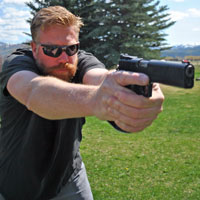Firearms Safety Revisited by Shepard Humphries
Firearms Safety Revisited by Shepard Humphries is a work in progress. Shepard has been involved with firearms and tactical training for over 25 years, and as a leader in advanced teaching strategies, offers insights that might help others develop their personal and professional firearms safety worldviews. Remember to consult with your attorney before implementing any of the ideas mentioned.
Work in progress….
Philosophy of firearms safety
When I was in law enforcement, I was fortunate enough to know that I was much better than “them” and that my firearms safety was just fine. Years later, I learned the dogmatic NRA firearms safety perspective. My friend Sonny Puzikas shared his perspectives with me about “square ranges” versus dynamic real-world training. Meanwhile I taught thousands of students and my team coached an additional 10,000+ students. I have some new perspectives.
I contemplate a certain hunk of metal weighing thousands of pounds flying by within 2 feet of a bicyclist on a highway. As the driver of the metal car approaches and passes, he has many seconds in which he can incorrectly aim his metal, and yet we are not appalled by a car passing the bicycle.

Imagine a person aiming a 230 grain piece of metal that focuses on aiming for even longer, but the direction is released in a single 1/8 second of trigger press. This shot is aiming 3 feet to the side of a person, and we are aghast.
On the one hand, I appreciate the dogmatic and verbose idealism of a recent NRA Instructor graduate, who, from his esteemed and dominant perch on top of the world, proclaims that “never ever should any gun be pointed at another person, even if both parties have triple-checked that it is empty.” Some pistol action shooters have similar dogmatic worldviews about when to have guns loaded or unloaded. Gabe Suarez, on the other hand, suggests that it mocks one’s intelligence to say that, “All guns are always loaded” and I agree with him. Perhaps we should TREAT all guns as though they are loaded? Perhaps not?
I contemplate a certain hunk of metal weighing thousands of pounds flying by within 2 feet of a bicyclist on a highway. As the driver of the metal car approaches and passes, he has many seconds in which he can incorrectly aim his metal, and yet we are not appalled by a car passing the bicycle. Imagine a person aiming a 230 grain piece of metal that focuses on aiming for even longer, but the direction is released in a single 1/8 second of trigger press. This shot is aiming 3 feet to the side of a person, and we are aghast.
Sticking with the car analogy, I will walk behind a running car with a driver in her seat in the parking lot, with the reverse lights on, because this stranger and I nodded at each-other, communicating that she will keep her foot on the brake. Why won’t I walk in front of a rifle shooter who has her round chambered, gun on safety and finger off the trigger?
“There are 10 basic safety rules.” “Their are 25 safety tips.” “There are three rules of gun safety.” I have seen many lists and heard many arguments. I have observed lousy handling and behavior that I perceive to be overly cautious. While I am disliked by many people for my stance on certain divisions of the NRA, I happen to really like their three basic rules of gun safety.
- Always keep the gun pointed in a safe direction.
- Always keep your finger off the trigger until you are ready to shoot.
- Always keep your gun unloaded until ready to use.
As with all “always” rules, there are exceptions. Generally, it is not wise to stand in front of a car driving toward you, but if you are a professional action photographer for “Porsche Times” there are times this rule will be broken. I am OK with this. This is part of an honorable philosophy of stoic voluntaryism in which everything is voluntary, and if a well-informed photographer chooses to voluntarily accept higher risk under controlled conditions; great! We are each responsible for the consequences of our actions, and we each have different risk preferences.
Let’s return to the topic of dynamic firearms training. I choose to limit my liability, so I do not participate in this high speed, low drag style of training. If one of my clients was faced with a 90% probability of being in a gunfight the following week, I would certainly suggest that they consider a higher-risk style of training. Some training classes include students walking back and forth from left to right between targets and shooters as other students shoot the targets. This is much better preparation for a gunfight than a static “square range” and it also comes with higher risk.
https://youtu.be/lyFovGe-jSA
Always keep the gun pointed in a safe direction.
I describe “safe direction” as the direction that, if the gun fires, the bullet will do the least amount of damage to people and property. This is, in truth, better called “the safest” direction. In many circumstances, there is not any direction that would not pose a risk to property, for example when handling your gun in your kitchen. Consider the 64,800 directions that a gun could be pointed at any moment, which is safest?
This rule includes shoot-throughs, knowing your target and what is beyond, and skyline shooting.
Always keep your finger off the trigger until you are ready to shoot.
This rule, as with most rules, is often “broken” in special circumstances. Some people argue that, “My partner and I are trained operators, our fingers are often on the trigger when we are not ready to shoot, we are grown men and have control over our fingers, we know the difference between pulling the trigger and not pulling it.” I believe that several hundred warriors throughout the world are capable of this. I worry about the 200,000 man-boys who “run” clean “kit” who think they are a warrior who is capable of this.
As for me, I really subscribe to disciplined finger control. If I do not intend to fire within a second or two, my finger if not on the trigger.
Always keep your gun unloaded until ready to use.
Does this mean that a person carrying a firearm for defensive purposes should keep it unloaded until ready to shoot? No, the word we should focus on is use. The use of a defensive firearm is immediate readiness to use the tool for defense, and being loaded is part of that. What about Utah/Israeli carry? This refers to having the chamber empty, adding an additional step or several to making the gun ready to shoot. There are arguments for and against this style, my counsel is to be consistent, and to practice your malfunction drills.
Relevant CV for Shepard Humphries:
- “Top Shot” award in San Diego, CA – San Diego Sheriff’s Explorer academy 1990
- Basic Law Enforcement Firearms & Tactical Training in Orange County, CA – O.C. Sheriff’s Dept Training Academy 1994
- Basic handgun & tactical training – Hermosa Beach Police Department 1997
- Annual handgun & shotgun training in Teton County, WY – Jackson Police Department 1998-2005
- SWAT Training including Entry Team, Perimeter Team and finally Sniper Team, advancing to Asst. Team Leader, then Team Leader – Jackson Hole Multi-Jurisdictional Tactical Team 2001-2005
- NRA Certified Instructor in Pistol, Home Firearms Safety, Rifle, Shotgun, Chief Range Safety Officer, Personal Protection Inside the Home – Utah 2010
- NRA Appointed Training Counselor – Raton, NM 2012
- Owner & manager of JH Shooting Experience & Nomad Rifleman, serving approximately 20,000 students from 2009 to 2020
- NRA Range Development & Operations course – 2014
- Other: Completed many related training courses including 3-day Crisis Management & Hostage Negotiation, 1-week sniper training by special forces team, 1-week rifle training at a lousy school in S/W Nevada. Worked with FBI & Secret Service on various firearms training and executive protection details, competitive pistol and tactical long range rifle shooter, developed a concealed carry course, traveled throughout Wyoming training and certifying Range Safety Officers…


